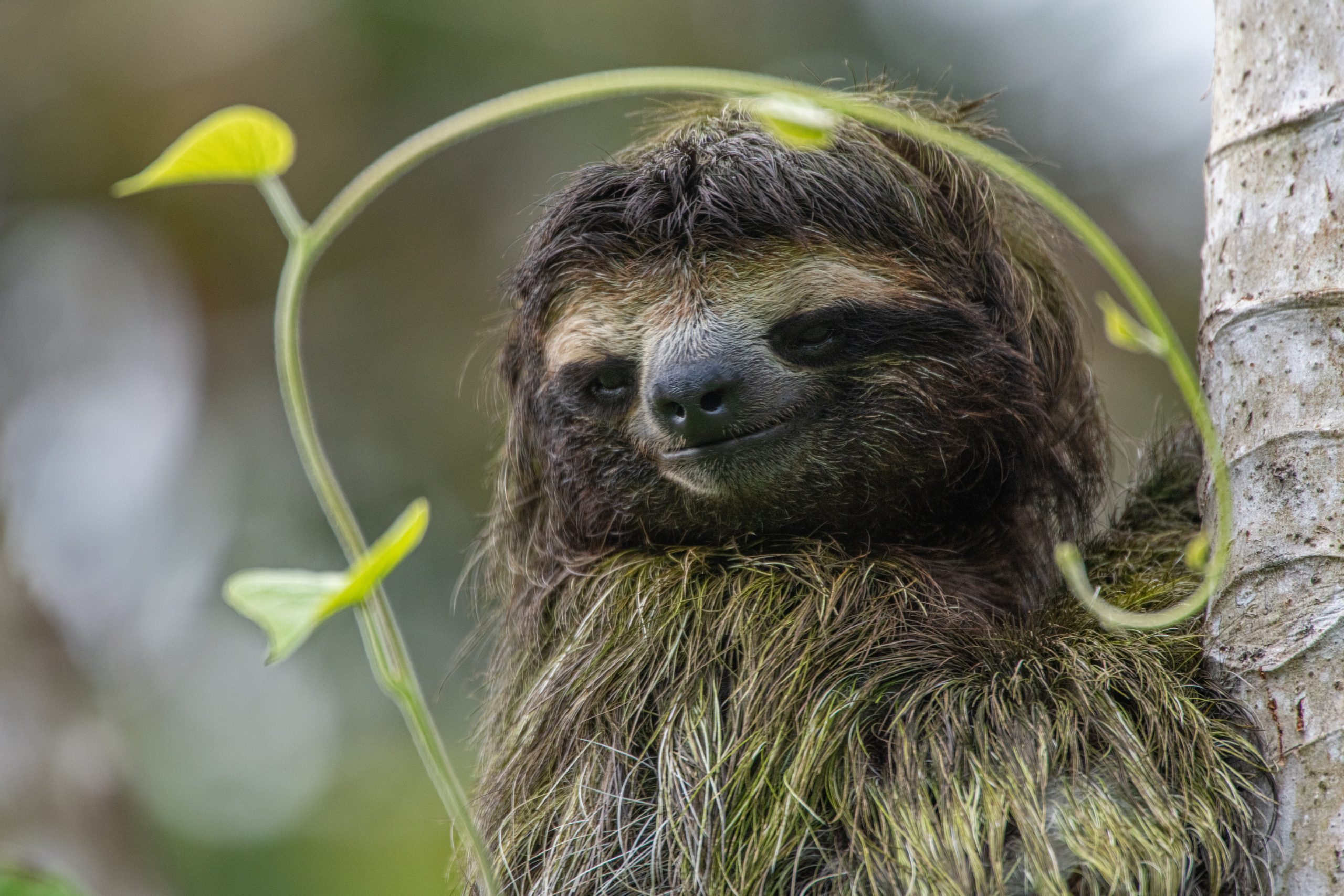
We bring to you details about 10 Animals in Tropical Rainforest.
The tropical rainforest is one of the most biodiverse ecosystems on Earth, home to a wide variety of animals.
Here are some examples of animals found in tropical rainforests:
1. Jaguar

Jaguars are primarily found in tropical rainforests and other dense jungle habitats throughout Central and South America. They are well adapted to these environments and are considered the largest big cat species native to the Americas.
Here are some key points about jaguars in tropical rainforests:
- Habitat: Jaguars are mainly found in the dense vegetation of tropical rainforests, including the Amazon rainforest, the Pantanal wetlands, and the forests of Central America. These areas provide the jaguars with abundant prey and cover for hunting.
- Adaptations: Jaguars have several physical adaptations that enable them to thrive in tropical rainforests. They have a stocky and muscular build, powerful jaws, and strong limbs for climbing trees and navigating through dense vegetation.
- Hunting: Jaguars are apex predators and are known for their exceptional hunting skills. They are capable of climbing trees and ambushing their prey from above. They mainly feed on large mammals such as capybaras, peccaries, deer, and sometimes even caimans.
- Camouflage: The coat of a jaguar is typically yellow or orange with distinct black rosettes, which helps them blend into the dappled sunlight and shadows of the rainforest. This camouflage is essential for stealthy hunting and remaining undetected by both prey and potential competitors.
- Range and Conservation: Jaguars have a broad distribution range, stretching from Mexico to Argentina. However, due to habitat loss, poaching, and other human activities, their populations have declined significantly. Efforts are being made to protect their habitats and conserve the species in various protected areas and national parks.
It’s important to note that jaguars are a vulnerable species and face numerous threats. Conservation initiatives, habitat preservation, and raising awareness about the importance of protecting these magnificent animals are crucial for their long-term survival.
2. Toucan
Toucans are indeed found in tropical rainforests. They are iconic birds known for their large and colorful bills, which make them easily recognizable. Toucans belong to the family Ramphastidae and are native to the tropical regions of Central and South America.
In rainforest habitats, toucans play an important role in seed dispersal. They have a varied diet consisting of fruits, insects, and sometimes even small lizards and eggs. Their long bills help them reach fruits that are otherwise inaccessible to many other birds.
Toucans are well adapted to the rainforest environment. Their bright colors and large bills are thought to play a role in courtship and species recognition. Their bills are lightweight despite their size, which allows them to maneuver through the dense vegetation of the rainforest.
These birds are typically found in the canopy of the rainforest, where they build nests in tree cavities. They are generally social birds and can be seen in small groups or flocks, often engaging in vocal communication with one another.
Some common species of toucans found in tropical rainforests include the Keel-billed Toucan (Ramphastos sulfuratus), the Chestnut-mandibled Toucan (Ramphastos swainsonii), and the Toco Toucan (Ramphastos toco).
Overall, toucans are fascinating and beautiful birds that contribute to the biodiversity and ecological balance of tropical rainforest ecosystems.
3. Orangutan
Orangutans are fascinating creatures that are primarily found in the tropical rainforests of Southeast Asia, specifically on the islands of Borneo and Sumatra. They are the only great apes that are native to Asia and are well-adapted to their rainforest habitat.
Orangutans are arboreal animals, which means they spend most of their lives in trees. They have long arms and strong hands and feet, enabling them to navigate through the treetops with ease. Their bodies are covered in reddish-brown hair, which helps them blend in with the forest canopy.
These intelligent primates are known for their exceptional problem-solving skills and use of tools. They are primarily vegetarian, with their diet consisting of fruits, leaves, bark, and occasionally insects. Orangutans have a slow reproductive rate compared to other primates, with females giving birth to a single offspring once every six to eight years.
The tropical rainforest provides essential resources for orangutans, including food, shelter, and protection. However, their habitat is under constant threat due to deforestation, illegal logging, and the expansion of palm oil plantations. These factors have led to a significant decline in orangutan populations, making them critically endangered species.
Conservation efforts are crucial for the survival of orangutans and the preservation of their rainforest habitat. Various organizations and governments are working towards protecting these amazing creatures by establishing national parks, promoting sustainable practices, and raising awareness about the importance of conserving their habitat.
In summary, orangutans thrive in the tropical rainforests of Borneo and Sumatra. They are tree-dwelling primates with distinct physical characteristics and behaviors. However, their existence is threatened by habitat loss, and concerted efforts are needed to ensure their long-term survival in the wild.
4. Sloth

Sloths are fascinating creatures that are commonly associated with tropical rainforests. They are known for their slow-moving nature, which allows them to conserve energy and spend most of their lives in trees. Here’s some information about sloths in tropical rainforests:
Habitat: Sloths primarily inhabit the tropical rainforests of Central and South America, including countries like Costa Rica, Brazil, and Panama. These rainforests provide them with the ideal environment, characterized by dense vegetation and abundant food sources.
Behavior and Adaptations: Sloths have several adaptations that help them survive in the rainforest. Their slow metabolism and low-energy lifestyle allow them to thrive on a diet consisting mainly of leaves. Their long, curved claws enable them to grip tree branches securely, allowing them to hang upside down for extended periods. This behavior also helps them stay hidden from predators and conserve energy.
Diet: Sloths are herbivores, primarily feeding on the leaves, buds, and fruits of trees. They have a specialized digestive system to process their fibrous diet efficiently. However, leaves provide limited nutritional value, so sloths have adapted to extract as many nutrients as possible through a slow digestion process that can take several days.
Movement: Sloths are renowned for their slow movement, and they spend the majority of their time hanging upside down in trees. They have a unique method of descending from trees known as the “sloth crawl.” By gripping branches with their strong claws, they slowly inch their way down, relying on their strong arms and hind legs to support their weight.
Predators: While sloths have few natural predators due to their arboreal lifestyle and camouflage, they are still vulnerable to predators like jaguars, large birds of prey, and snakes. Their slow movements and excellent camouflage help them stay hidden from these predators.
Conservation: Sloths face several threats in tropical rainforests, including deforestation, habitat loss, and the illegal pet trade. Deforestation disrupts their natural habitat, leaving them exposed and vulnerable. Conservation efforts are underway to protect sloth populations and their rainforest habitats through habitat preservation, education, and efforts to combat the illegal wildlife trade.
Overall, sloths are intriguing inhabitants of tropical rainforests, perfectly adapted to their unique environment. Their slow pace of life and distinct characteristics make them an iconic species associated with these lush and diverse ecosystems.
5. Poison dart frog

The poison dart frog is a fascinating creature that is commonly found in tropical rainforests, particularly in Central and South America. Here’s some information about poison dart frogs and their habitat:
- Habitat: Poison dart frogs primarily inhabit the dense tropical rainforests of Central and South America, including countries like Costa Rica, Colombia, Brazil, and Ecuador. They prefer areas with high humidity, abundant rainfall, and a diverse range of plant life.
- Diversity: There are over 200 known species of poison dart frogs, with varying colors and patterns. Some species exhibit vibrant and striking colors, which serve as a warning to potential predators about their toxic nature.
- Toxicity: Poison dart frogs are known for their potent skin toxins, which are derived from their diet in the wild. These toxins, such as alkaloids, serve as a defense mechanism against predators. However, in captivity, where their diet changes, they usually lose their toxicity.
- Microhabitats: Poison dart frogs inhabit various microhabitats within the rainforest, including the forest floor, leaf litter, fallen logs, and the base of trees. They are excellent climbers and can often be found on low vegetation, such as bushes and shrubs.
- Breeding: Poison dart frogs are known for their unique breeding behavior. They typically lay their eggs in small pools of water, such as in bromeliads or leaf axils, high up in trees. Once the eggs hatch, the male frog carries the tadpoles on his back to transport them to larger bodies of water like streams or ponds.
- Conservation: Some species of poison dart frogs are threatened or endangered due to habitat loss, pollution, and illegal collection for the pet trade. Efforts are being made to protect their natural habitats and regulate their trade to ensure their survival in the wild.
- Ecological role: Poison dart frogs play a crucial role in their ecosystems. They are insectivores, feeding on small invertebrates like ants, termites, and beetles. By controlling the populations of these invertebrates, they help maintain the balance of their rainforest ecosystem.
It’s important to note that interacting with poison dart frogs in their natural habitat can be dangerous. While some species kept in captivity lose their toxicity, wild poison dart frogs retain their potent toxins. So, it’s always best to observe these incredible creatures from a safe distance and avoid touching or handling them.
READ ALSO: 10 Ecotourism Destinations In USA
6. Harpy eagle
The harpy eagle (Harpia harpyja) is a magnificent bird of prey found primarily in the tropical rainforests of Central and South America. It is one of the largest and most powerful eagles in the world, known for its striking appearance and impressive hunting skills.
Here are some key facts about the harpy eagle in the tropical rainforest:
- Habitat: Harpy eagles inhabit the upper canopy layer of lowland tropical rainforests. They prefer large expanses of undisturbed forest with tall, mature trees, where they can find suitable nesting sites and an abundance of prey.
- Range: The harpy eagle’s range extends from southern Mexico through Central America to northern Argentina and Brazil. It is most commonly found in countries like Brazil, Belize, Panama, and Ecuador.
- Diet: Harpy eagles are apex predators and primarily feed on a variety of large mammals and arboreal animals. Their diet includes sloths, monkeys, tree-dwelling anteaters, opossums, and certain birds. They are opportunistic hunters and rely on stealth and surprise to capture their prey.
- Adaptations: Harpy eagles have several adaptations that enable them to thrive in the rainforest. Their large, powerful talons are specially designed for capturing and grasping prey. They also have exceptionally keen eyesight, which helps them locate animals hiding in the dense foliage.
- Nesting and Reproduction: Harpy eagles construct large nests high up in the canopy, usually in tall emergent trees. These nests can measure up to 1.2 meters (4 feet) in diameter and are used for multiple breeding seasons. The female lays one or two eggs, and both parents participate in incubating them and raising the chicks.
- Conservation Status: The harpy eagle is considered Near Threatened by the International Union for Conservation of Nature (IUCN). Habitat loss due to deforestation, illegal hunting, and disturbance are the primary threats to their population. Efforts are being made to protect their habitats and raise awareness about their conservation.
Observing a harpy eagle in the wild is a rare and remarkable experience due to its elusive nature and restricted range. These majestic birds play a vital role in maintaining the balance of rainforest ecosystems and serve as indicators of the overall health of the habitat they inhabit.
7. Capybara
Capybaras are not typically found in tropical rainforests. They are native to South America and are commonly found in a variety of habitats such as savannas, wetlands, and forested areas, including the Amazon rainforest.
While capybaras can tolerate and adapt to different environments, they are usually found near bodies of water, such as rivers, lakes, and marshes. These semi-aquatic mammals rely on water for various activities, including swimming and cooling off in hot weather.
In tropical rainforests, capybaras may inhabit the forested areas near rivers or lakes where they can find sufficient water and vegetation for feeding. However, they are not exclusively limited to tropical rainforest habitats and can be found in other types of ecosystems as well.
8. Howler monkey
Howler monkeys are fascinating creatures that are found in tropical rainforests in Central and South America. They are known for their distinctive howling vocalizations, which can be heard from miles away and are used to communicate with other members of their troop. Here are some key facts about howler monkeys in tropical rainforests:
- Habitat: Howler monkeys primarily inhabit the upper canopy layer of tropical rainforests. They are well adapted to life in the trees and rarely come down to the forest floor.
- Range: Howler monkeys are found in several countries across Central and South America, including Mexico, Belize, Costa Rica, Panama, Brazil, and Argentina, among others. Their specific range depends on the species.
- Diet: Howler monkeys are predominantly folivores, meaning they mainly feed on leaves. Their specialized digestive system allows them to efficiently extract nutrients from leaves, which are not particularly high in nutritional value. They may also eat fruits, flowers, and occasionally small insects.
- Social Structure: Howler monkeys are social animals and live in groups known as troops. A typical troop consists of several individuals, usually led by a dominant male. The group may also include several adult females and their offspring. Howler monkeys have a strong bond within their troop and will defend their territory from other troops.
- Howling: The distinctive howling of howler monkeys is one of the loudest sounds produced by any land mammal. It is primarily a territorial display to communicate with other troops and to warn potential intruders. Howling helps them establish their presence and avoid unnecessary conflicts.
- Physical Features: Howler monkeys have a robust build with a stocky body covered in thick fur that can range from brown to black in color. They have a prehensile tail, which means it can grasp and hold onto branches, aiding in their arboreal lifestyle. Howler monkeys also have a large throat and a specialized voice box (hyoid bone) that allows them to produce their deep, resonating howls.
- Conservation Status: While howler monkeys are not currently considered endangered, they face various threats due to habitat loss and fragmentation caused by deforestation and human activities. It’s important to protect their rainforest habitat to ensure their survival.
Remember that specific information may vary depending on the exact species of howler monkey you are referring to, as there are several different species within the group.
9. Tree kangaroo
The tree kangaroo is a fascinating marsupial that inhabits the tropical rainforests of certain regions. While most kangaroo species are known for their terrestrial lifestyles, tree kangaroos have adapted to life in the trees, enabling them to navigate the forest canopy with ease. Here’s some information about tree kangaroos in tropical rainforests:
Habitat: Tree kangaroos are found in the tropical rainforests of Papua New Guinea, Indonesia (specifically the islands of New Guinea and some surrounding islands), and northeastern Australia. These regions provide the ideal environment for tree kangaroos, as they offer dense vegetation, tall trees, and abundant food sources.
Physical Adaptations: Tree kangaroos have several adaptations that enable them to live in the trees. They possess strong limbs, well-developed forelimbs, and long claws that help them climb and grip tree branches. Their hind limbs are also powerful, allowing them to make impressive leaps from tree to tree. Tree kangaroos have a long, muscular tail that aids in balance while climbing and jumping.
Diet: The diet of tree kangaroos primarily consists of leaves, flowers, fruits, and bark. They are known to feed on a wide variety of plant species found in the rainforest canopy. Their specialized digestive system allows them to extract as many nutrients as possible from their plant-based diet.
Behavior and Lifestyle: Tree kangaroos are largely arboreal, spending most of their time in trees. They have the ability to move both vertically and horizontally through the forest canopy, aided by their strong limbs and prehensile tail. Tree kangaroos are generally solitary animals, except during mating season. They are also known for their slow and deliberate movements, carefully navigating the tree branches to avoid falls.
Conservation Status: Many tree kangaroo species are currently threatened or endangered due to habitat loss, hunting, and other human activities. Deforestation, particularly for logging and agriculture, poses a significant threat to their survival. Conservation efforts are focused on protecting their habitats, raising awareness, and implementing sustainable practices to ensure the long-term survival of these unique animals.
Overall, tree kangaroos are remarkable creatures that have adapted to thrive in the challenging environment of tropical rainforests. Their arboreal lifestyle and specialized physical features make them well-suited to life high above the forest floor. However, their conservation status emphasizes the need for increased efforts to protect their habitats and preserve the biodiversity of these crucial ecosystems.
10. Anaconda
Anacondas are large, non-venomous snakes that are commonly found in tropical rainforests, particularly in South America. They are known for their impressive size and strength, with the green anaconda being the largest snake species in the world.
The tropical rainforests of South America provide the ideal habitat for anacondas. These rainforests have a warm and humid climate, which is necessary for the survival of these reptiles. Anacondas are semiaquatic, spending a significant amount of time in or near bodies of water such as rivers, swamps, and marshes. The rainforest environment provides an abundant supply of water sources, making it suitable for their lifestyle.
Anacondas are excellent swimmers and can navigate through the water with ease. They use their muscular bodies and strong tails to propel themselves, making them efficient hunters in aquatic environments. They prey on a variety of animals, including fish, amphibians, birds, and mammals, and their large size allows them to ambush and overpower their prey.
While anacondas are most commonly associated with the Amazon rainforest, they can also be found in other tropical rainforest regions of South America, such as the Orinoco basin and the Guianas. These snakes are highly adaptable and can inhabit various types of aquatic and terrestrial habitats within the rainforest, including flooded areas during the wet season.
It’s important to note that although anacondas are powerful predators, they are not a significant threat to humans. They prefer to avoid human interaction and are generally docile unless provoked or threatened. Nonetheless, it is always advisable to exercise caution and respect when encountering any wildlife in their natural habitat.
These are just a few examples of the many fascinating animals that inhabit tropical rainforests. The incredible diversity of species in these ecosystems is truly remarkable.








